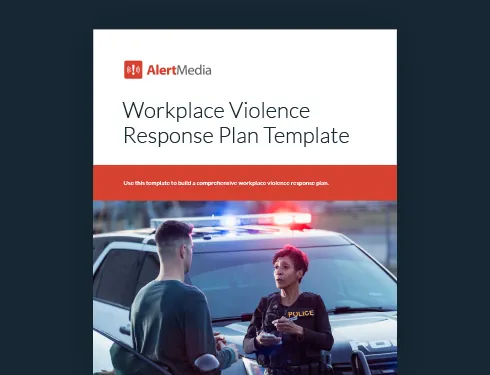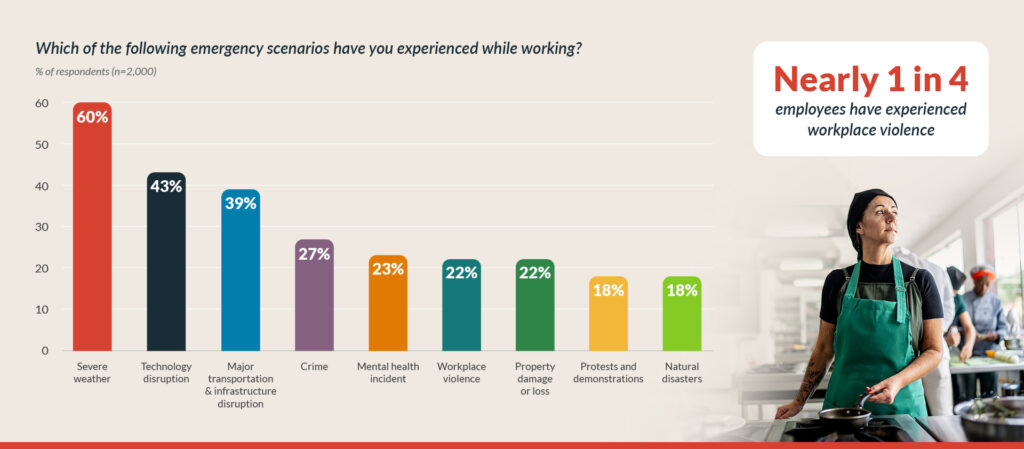
Senate Bill 553: Workplace Violence Prevention Plans for California Businesses
California bill 553 establishes new requirements for employers aimed at protecting workers from workplace violence. Here’s what you need to know to ensure compliance.

While most data shows that violent crime is dropping in the U.S., California is an unfortunate outlier. Recent data from the Golden State showed that these crimes increased at a rate 31% higher than the U.S. average. In examining why these rates are growing, it’s also important to look at where they’re coming from. Even as millions of workers went remote, workplace violence rates still managed to rise—especially among those in public-facing jobs. To protect workers and the public, lawmakers in California passed Senate Bill No. 553. SB 553 expands on several existing laws to give employers and worker representatives the tools they need to prevent and prepare for violence in the workplace.
Download Our Workplace Violence Response Plan Template
What Is SB 553 and Why Is It Needed?
SB 553, signed into law by Governor Gavin Newsom on September 30, 2023, aims to tackle increasing overall violence in California, as well as rising occurrences of mass shootings. Our data confirms this trend and reveals that workplace violence is a prevalent issue nationwide, with nearly one in four workers having experienced some form of workplace violence in the past.

While the state has several existing laws in place to protect workers and establish a duty of care for employers, the amendments put forth in the Senate bill strengthen them. Specifically, SB 553 expands who may pursue restraining orders to protect workers; establishes structured planning, logging, and record-keeping guidelines; and mandates worker training.
However, SB 553 does not apply to all workplaces. There are a few basic exemptions, including:
- Worksites with fewer than 10 employees that are not accessible to the public
- Teleworking employees
- Healthcare facilities, which are covered under a separate OSHA mandate
- California law enforcement and departments of corrections agencies participating in the POST program
With those few exemptions, nearly all California employers must adhere to new requirements established under SB 553.
How Can Your Business Comply with California Bill 553?
Provisions in this California law go into effect between July 1, 2024, and January 1, 2025. While the bill itself is extensive, it mainly incorporates five broad provisions that businesses should be aware of to stay compliant.
When Can Employee Representatives Seek Restraining Orders?
SB 553 introduces amendments to California’s Code of Civil Procedure, expanding the rights of employers to seek temporary restraining orders for employees who have experienced unlawful violence or credible threats. Notably, this legislation extends these protections to collective bargaining representatives, recognizing their role in workplace advocacy and negotiation.
Given the complexity of legal statutes and the potential implications for businesses, it’s advisable for employers to seek legal advice from experts. Policies for potential workplace violence emergencies can be outlined in your workplace violence prevention plan, which is the next major update to SB 553.
How to Establish a Workplace Violence Prevention Plan
One of the next major provisions of SB 553 amends California’s Labor Code to include a requirement to establish a written workplace violence prevention plan. This can be a stand-alone section or part of a broader injury and illness prevention plan that incorporates effective procedures to:
- Designate responsibilities for plan implementation
- Address specific hazards based on places of employment and worksites
- Facilitate active involvement of employees and authorized representatives
- Coordinate plan implementation and notifications with other employers, as applicable
- Respond effectively to reports of workplace violence
- Follow reporting requirements on incident investigations and corrective measures
- Ensure compliance with the plan by both supervisory and nonsupervisory employees
- Establish effective communication regarding workplace violence matters
- Develop and provide required training on workplace violence prevention
- Identify, evaluate, and correct workplace violence hazards
- Regularly review and revise the plan
While that list is extensive with the individual components broken down, it follows other disaster response plans or all-hazards strategies essential for safeguarding employees. Modeling the plan after an emergency management framework, while tailoring steps for addressing workplace violence, establishes prevention as the cornerstone while ensuring compliance with California law.
As Matt Doherty, Managing Director of Workforce Risk Management at Sikich, emphasized in an interview on The Employee Safety Podcast, workplace violence policies should transcend mere post-incident response plans and prioritize proactive workplace violence prevention.
Assign roles and foster communication
While California Bill 553 mandates businesses to designate a responsible party for their workplace violence plans, it’s imperative to consider this assignment carefully. The responsibilities under this plan involve sensitive matters and a high need for empathy. Often, good candidates can be found in human resources or management positions, where they possess the necessary interpersonal skills and understanding of company dynamics to handle such delicate situations effectively. You can ensure thorough policy implementation and a safer working environment for all employees by selecting the right individuals.
Workers must feel empowered to come forward with concerns regarding potential workplace violence. However, as Matt pointed out in his recent sit-down with podcast host Peter Steinfeld, SVP of Safety Solutions at AlertMedia, many workplace violence policies tend to be punitive, which can deter individuals from speaking up.
“There’s a lack of reporting because of the punitive nature of the policies that say workplace violence won’t be tolerated,” Matt explains. “Therefore, [an employee’s] reaction is they don’t want to get involved. We’ve done training after the fact where people have been harmed … and we’ve seen the devastating effect of the guilt that coworkers feel that they did not report a concerning situation.”
One strategy Matt emphasizes to encourage open communication is establishing a non-punitive approach. This can include implementing open policies on how restraining orders are handled for employees and reminding them of state laws preventing discrimination against them if they choose to report incidents. It can also involve providing anonymous tip lines for reporting concerns, offering access to support services, and emphasizing that support through periodic training. This creates a safety culture where workers are comfortable coming forward, which Matt notes is vital for prevention.
Collaborate with law enforcement on risk assessment
There are a few industries and roles in which the risk of workplace violence is more likely due to the inherent risk of the job. Those who work handling money, in security, or with volatile members of the public, such as drug and alcohol counselors, are often at higher risk of workplace violence on the job. Organizations need to have detailed plans for these specific risks. However, there are less obvious risks affecting every workforce that may not get adequate attention.
Unfortunately, the tendency for individuals to conceal precursors to workplace violence—including domestic violence, mental health issues, and substance abuse—can significantly hinder the accurate risk assessment regarding intentional violence against workers. Matt emphasizes that this challenge can be addressed through communication strategies that create a non-punitive, safe space for reporting, as well as through collaboration with outside parties, such as law enforcement.
Matt reports that law enforcement responses to these issues have evolved in recent years. Twenty years ago, he notes, local police would have been unlikely to respond proactively to a call about a planned termination involving an employee with a violent history. However, due to the prevalence of workplace incidents, including mass shootings, they are now more likely to adopt a preventative stance and assist in proactive threat assessments.
Establishing a liaison with local law enforcement can help keep employees informed about potential threats and provide valuable support in assessing and managing risks. However, it’s crucial to strike a balance between maintaining law enforcement connections and fostering a comfortable workplace environment. Matt suggests that the key is for law enforcement to be discreetly aware of any potential issues in the workplace to help address them early. It’s preferable to have them readily available with full awareness of the risks, rather than have to bring them up to speed after an incident occurs.
With a more accurate understanding of the risks an organization faces, workers can receive training on the policies and procedures that will keep them safe and prevent violence.
Log and learn from incidents with employee training
Under SB 553, businesses must keep a violent incident log for every incident. However, due to the sensitive nature of these situations, the employer is expected to omit any and all information that could reveal an individual’s identity, including names, addresses, emails, and other personally identifiable information. Plan to include:
- Date and time of the incident
- Type of workplace violence involved (e.g., personal relationship, client-worker, worker-on-worker, criminal intent)
- Detailed description of the incident
- Classification of the perpetrator (e.g., client, coworker)
- Location of the incident
- Circumstances at the time of the incident
- Type of incident (e.g., physical attack, threat)
- Response to the incident (e.g., security/law enforcement response)
- Information about the person completing the log (name, job title, date completed)
Keep in mind that this log is a separate one from those required by the Occupational Health and Safety Administration. OSHA logs of injuries should be recorded separately for affected organizations. In this requirement, there is a provision that states, “The log shall be reviewed during the periodic reviews of the plan.”
Even if this weren’t mandated, it would still be a beneficial idea. Comparing the workplace violence incident log to the plan itself can help employers enhance prevention efforts.
For example, during the yearly log review of violent incidents in a warehouse, a company discovers a gap in its plan that may not have been accounted for. Several of the assaults have occurred as a result of “tailgating” or unauthorized individuals entering the area while following workers. The organization realizes that they’ve failed to include situational awareness training that would have secured access points.
This is a common oversight that’s specifically detrimental in workplace violence situations. Individuals don’t know what to look for and are often unaware of their surroundings. This can even be true for individuals who’ve worked on the same worksite for years. They become complacent and, as a result, are less likely to identify threats of physical harm.
Situational awareness training can help hone skills around this and aid in prevention. This training teaches employees to be vigilant and observant of their surroundings, recognize potential threats or unusual behaviors, and know how to respond effectively in various situations.
This training can include identifying suspicious individuals or activities, understanding escape routes and safe areas, and practicing communication strategies to alert others or seek help when needed. Regular reinforcement and practice of these skills can help employees stay alert and prepared to prevent workplace violence incidents.
To get started with some basic situational awareness training materials, download this helpful template.
Preparing for and Preventing Workplace Violence
SB 553 is California’s latest update to protect workers and provide businesses with the tools and framework they need to help. This bill expands on the need to take more preventative measures and ensure strategies are in place to mitigate damages. While workplace violence cannot always be predicted, it is imperative for organizations to prioritize emergency preparedness planning.
Developing comprehensive emergency response protocols, conducting regular training sessions, and fostering a culture of awareness and preparedness can significantly enhance the workplace safety and security of both employees and businesses. Proactive measures not only reduce the risk of violence but also contribute to creating a safer and more resilient work environment for all stakeholders involved.
Download our Emergency Response Plan Template to create strategies to prepare for and prevent workplace violence.




